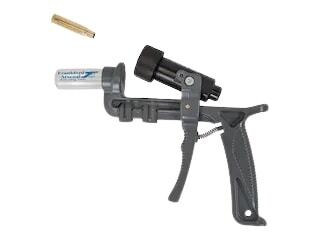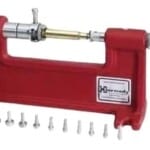
Introduction to Depriming
Depriming, also known as decapping, is a crucial first step in the reloading process. It involves removing the spent primer from a fired cartridge case to prepare it for resizing, cleaning, and reloading. Whether you're a beginner reloader or an experienced handloader looking for best practices, understanding the correct depriming techniques will improve efficiency, enhance safety, and help produce high-quality, consistent ammunition.
In this guide, we will cover:
- The best tools and methods for depriming
- Safety considerations to prevent accidents
- How to inspect and clean primer pockets after depriming
- Handling military crimped primers and alternative depriming methods
- Proper disposal of spent primers
By the end of this article, you will have a complete understanding of depriming and how to optimize your reloading workflow.
Safety First: Precautions Before Depriming
Depriming involves working with fired brass cases that have been exposed to combustion residue, carbon deposits, and in some cases, potentially hazardous primer compounds. Proper safety precautions should always be followed to prevent injury or exposure to harmful residues.
Essential Safety Measures
✅ Wear Eye Protection:
Spent primers can eject unexpectedly and at high speeds, especially if they are crimped or lodged tightly. Always wear ANSI-rated safety glasses when depriming.
✅ Ensure the Case is Spent:
NEVER attempt to deprime a live primer. Accidental detonation of an unfired primer can cause serious injury. If unsure whether a case has a live primer, handle it with extreme caution.
✅ Keep Your Workspace Well-Ventilated:
Primers, particularly older military or surplus types, may contain lead-based or corrosive compounds. Working in an area with proper airflow minimizes exposure to airborne residues.
✅ Keep Open Flames and Sparks Away:
Primers contain impact-sensitive compounds that can ignite under pressure or heat. Ensure your workspace is free of ignition sources such as open flames, cigarettes, or electrical sparks.
✅ Properly Dispose of Spent Primers:
Spent primers should be collected in a designated container and disposed of responsibly. Some reloaders choose to recycle them as scrap metal, while others follow local hazardous waste disposal guidelines.
Tools and Equipment Needed for Depriming
To efficiently remove spent primers, you will need the right tools. The best depriming tool depends on your specific reloading setup, frequency of depriming, and whether you are working with standard or crimped primers.
1. Decapping Dies (Depriming Dies)
A decapping die is the most common method for depriming and is installed in a reloading press. There are several types:
- Universal Decapping Dies – Designed to remove spent primers without resizing the case. Ideal for dirty brass or cases that will be wet tumbled before resizing. Examples include the Lee Universal Decapping Die and RCBS Universal Decapper.
- Caliber-Specific Decapping Dies – These are built into resizing dies, so depriming occurs simultaneously with case resizing. Examples include Redding, Hornady, and Dillon resizing dies with decapping pins.
- Heavy-Duty Decapping Dies – Used for military brass with crimped primers. The RCBS Heavy-Duty Decapping Die is a top choice.
2. Reloading Press
A reloading press provides mechanical leverage to drive the spent primer out of the case. Popular presses include:
- Single-Stage Presses – Best for beginners and precision reloaders (e.g., RCBS Rock Chucker, Lee Classic Cast).
- Turret Presses – Faster for mid-volume reloaders (e.g., Lyman Brass Smith Turret, Lee Turret Press).
- Progressive Presses – High-volume reloading (e.g., Dillon XL750, Hornady Lock-N-Load AP).
3. Hand Depriming Tools
For those who want to deprime cases separately before using a press, hand decappers are a great alternative. Examples include:
- Lee Universal Hand Decapper – A budget-friendly and portable tool.
- Frankford Arsenal Hand Deprimer – Features a primer catch system and ergonomic design for ease of use.
4. Primer Pocket Cleaning Tools
After depriming, the primer pocket must be cleaned for proper primer seating. Options include:
- Primer Pocket Brushes – Simple manual cleaning (e.g., Lyman Primer Pocket Cleaner).
- Primer Pocket Uniformers – Ensures consistent primer seating depth.
- Ultrasonic Cleaners or Wet Tumblers – Best for deep cleaning cases and primer pockets in large batches.
Step-by-Step Guide to Depriming a Cartridge Case
Step 1: Set Up Your Reloading Press
- Insert the appropriate shell holder into your press. The shell holder should match the caliber of the brass being deprimed.
- Install the decapping die and adjust it according to the manufacturer’s instructions.
Step 2: Insert the Cartridge Case
- Place a fired case into the shell holder.
- Pull the press handle to raise the case into the decapping die.
- The decapping pin will push out the spent primer, which will typically fall into a primer collection system or bin.
Step 3: Inspect and Clean the Primer Pocket
- Examine the primer pocket to ensure there are no obstructions or carbon buildup.
- If necessary, use a primer pocket brush or uniformer to remove debris.
Step 4: Identify and Handle Crimped Primers
- Military brass often features crimped primers that must be removed using a swaging tool (e.g., RCBS Primer Pocket Swager or Dillon Super Swage 600).
- A reaming tool can also be used to remove the crimp manually.
Alternative Methods for Depriming
1. Hydraulic Decapping (Rare but Effective)
Some reloaders use hydraulic pressure to force the primer out. This method is uncommon but useful for stubborn cases.
2. Manual Punch and Hammer Method
For emergency depriming, a decapping punch and hammer can be used, but this method is slow and requires precision.
Proper Disposal of Spent Primers
Spent primers contain lead compounds and should not be discarded carelessly. Best practices for disposal include:
- Collecting spent primers in a sealed metal or plastic container.
- Taking them to a recycling center or hazardous waste facility.
- Some reloaders melt them down for scrap brass.
Final Thoughts: Optimizing Your Depriming Process
Depriming is a foundational step in the reloading process. Using the right tools, following best practices, and understanding the nuances of primer pocket maintenance will ensure safe, consistent, and accurate reloads.
By integrating safety measures, proper tool selection, and primer pocket cleaning techniques, you’ll enhance the quality of your handloaded ammunition and extend the lifespan of your brass.
If you found this guide helpful, consider sharing it with fellow reloaders and bookmarking it for future reference.
Happy reloading! ??
Find depriming tools here.
If you know of any forums or sites that should be referenced on this listing, please let us know here.



